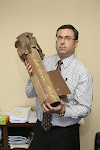The New York Celebrate Israel Parade was easy to spot. With Israeli flags blowing in the wind and an excess of Jewfros, I couldn’t have missed it. As I got closer to the meeting spot, I found myself surrounded by kippa-wearing guys and girls with knee-length denim skirts. The crowd appeared to be very Modern Orthodox. And I was in the section for university groups — not Jewish day schools.
The Forward reported that about half of the marchers came from Jewish day schools, and the overwhelming majority of these from Orthodox day schools. I would dare to venture that many of the synagogues and youth groups that were marching were also Orthodox-affiliated. The younger generation is the future, and between 5th Avenue and Madison, the future looked very Orthodox. There were a couple gay pride flags, but other than that, the crowd seemed less diverse than usual.
I think this speaks to a serious problem of non-Orthodox Judaism in the US: it isn’t engaging people, especially college students.
I have struggled with this problem at college. This past school year, I served as the president of the Reform Jewish group of Cornell. While I have made some close friends in the group, I also encountered many challenges, some of which seemed insurmountable.
Every Friday night, we were barely able to get a minyan (the ten-people quorum required to say certain prayers). As a Reform community, we count both men and women in the minyan, so this means we had trouble getting ten people to come to services. We had similar problems at social events.
Approximately 100 people attended our Rosh Hashanah services. If one assumes that a third of the approximately 3,000 Jews on campus are Reform (though in reality the percentage is probably highery), that means that only one out of ten Reform students attended High Holy Day services. And very few of these 100 students ever returned to any of our events or services.
The issue is not only a problem for the Reform group; in fact, the Conservative group often fared even worse.
Since being home for break, I have been attending Shabbat services at my Conservative home synagogue, and each time, I have been the youngest person in the room, not by a couple of years, but by decades. The older congregants have greeted me with open arms, but also with surprise.
Even sadder than the lack of engaged youths, Reform and Conservative Jews have gotten used to dismal attendance. At Cornell, we were ecstatic, not sad, when we had 15 out of 1,000 Reform Jews attend a weekly service. In my home synagogue, the older members really seemed puzzled why I would want to pray in my synagogue on a Friday night.
I do not think this failure means that the movements are doomed. There is great value in having different movements of Judaism, especially in the Diaspora. Instead of it being all-or-nothing, Jews can find a way of practicing Judaism that they feel connected to. Personally, I do not feel connected to a service that is not fully egalitarian. Others may find such services a turnoff. While diversity in Judaism is good, a movement must not become so lax that its members feel no connection to the religion they are supposedly practicing.
In college I have become friends with many Orthodox students who show a passion for Judaism and Israel that I rarely see in progressive Jews. There could be a lot of reasons why they are so engaged, such as the fact that many have attended Jewish day schools and yeshivas and that their parents are more invested in Judaism. But what I know for sure is that if the Reform and Conservative branches of Judaism want to have a future in America, they need to take the time to look at what the Orthodox movement is doing right.

